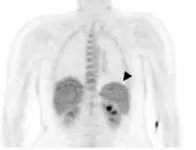(Press-News.org) Berkeley -- Global land-use changes -- including forest fragmentation, agricultural expansion and concentrated livestock production -- are creating "hot spots" favorable for bats that carry coronaviruses and where conditions are ripe for the diseases to jump from bats to humans, finds an analysis published this week by researchers at the University of California, Berkeley, the Politecnico di Milano (Polytechnic University of Milan) and Massey University of New Zealand.
While the exact origins of the SARS-CoV-2 virus remain unclear, scientists believe that the disease likely emerged when a virus that infects horseshoe bats was able to jump to humans, either directly through wildlife-to-human contact, or indirectly by first infecting an intermediate animal host, such as the pangolin, sometimes known as the scaly anteater. Horseshoe bats are known to carry a variety of coronaviruses, including strains that are genetically similar to ones that cause COVID-19 and severe acute respiratory syndrome (SARS).
The new study used remote sensing to analyze land use patterns throughout the horseshoe bat's range, which extends from Western Europe through Southeast Asia. By identifying areas of forest fragmentation, human settlement and agricultural and livestock production, and comparing these to known horseshoe bat habitats, they identified potential hot spots where habitat is favorable for these bat species, and where these so-called zoonotic viruses could potentially jump from bats to humans. The analysis also identified locations that could become easily become hot spots with changes in land use.
"Land use changes can have an important impact on human health, both because we are modifying the environment, but also because they can increase our exposure to zoonotic disease," said study co-author Paolo D'Odorico, a professor of environmental science, policy and management at UC Berkeley. "Every formal land use change should be evaluated not only for the environmental and social impacts on resources such as carbon stocks, microclimate and water availability, but also for the potential chain reactions that could impact human health."
Most of the current hot spots are clustered in China, where a growing demand for meat products has driven the expansion of large-scale, industrial livestock farming. Concentrated livestock production is particularly concerning because the practice brings together large populations of genetically similar, often immune-suppressed animals that are highly vulnerable to disease outbreaks, the researchers said.
The analysis also found that parts of Japan, the north Philippines and China south of Shanghai are at risk of becoming hot spots with further forest fragmentation, while parts of Indochina and Thailand may transition into hot spots with increases in livestock production.
"The analyses aimed to identify the possible emergence of new hot spots in response to an increase in one of three land use attributes, highlighting both the areas that could become suitable for spillover and the type of land use change that could induce hot spot activation," said study co-author Maria Cristina Rulli, a professor in hydrology and water and food security at the Politecnico di Milano in Italy. "We hope these results could be useful for identifying region-specific targeted interventions needed to increase resilience to coronavirus spillovers."
Human encroachment into natural habitat can also can indirectly increase exposure to zoonotic disease by reducing valuable biodiversity. When forest lands become fragmented and natural habitats are destroyed, species that require very specific habitat to survive, called "specialists," may dwindle or even go extinct. Without competition from specialists, "generalist" species, which are less picky about their habitat, can take over.
Horseshoe bats are a generalist species and have often been observed in areas characterized by human disturbance. Earlier work by Rulli, D'Odorico and study co-author David Hayman has also linked forest fragmentation and habitat destruction in Africa to outbreaks of the Ebola virus.
"By creating conditions that are disadvantageous to specialist species, generalist species are able to thrive," D'Odorico said. "While we are unable to directly trace the transmission of SARS-CoV-2 from wildlife to humans, we do know that the type of land use change that brings humans into the picture is typically associated with the presence of these bats who are known to carry the virus."
While China has been a leader in tree planting and other greening efforts over the past two decades, many of the trees have been planted in discontinuous land areas or forest fragments. To tilt the ecological balance back in favor of specialist species, creating continuous areas of forest cover and wildlife corridors are more important than increasing total tree cover.
"Human health is intertwined with environmental health and also animal health," D'Odorico said. "Our study is one of the first to connect the dots and really drill down into the geographic data on land use to see how humans are coming into contact with species that might be carriers."
INFORMATION:
Co-authors of the paper also include Nikolas Galli of the Politecnico di Milano and David Hayman of Massey University
This research was supported by the Eni Enrico Mattei Foundation (FEEM), the Cariplo Foundation (SusFeed project 0737 CUP D49H170000300007), Regione Lombardia (RUD0CONV01/ASSO project D44I20002000002), a Royal Society Te Apārangi Rutherford Discovery Fellowship RDF-MAU1701 MAU1701, and the Massey University Foundation.
Non-alcoholic fatty liver disease (NAFLD) is the most common cause of chronic liver disease worldwide. NAFLD patients are at higher risk of developing Non-alcoholic steatohepatitis (NASH), which causes severe and chronic liver inflammation, fibrosis and liver damage. A patient with NASH is believed to be at high risk for developing a form of liver cancer called hepatocellular carcinoma (HCC).
Apart from lifestyle interventions, there are currently no approved treatments for NASH. A liver transplant is sometimes the only remedy.
While risk factors for NASH (obesity, type-2 diabetes and gene mutations like PNPLA3) and HCC ...
CHAPEL HILL, North Carolina--Researchers have discovered a gene, OTUD7A, that impacts the development of Ewing sarcoma, a bone cancer that occurs mainly in children. They have also identified a compound that shows potential to block OTUD7A protein activity. The finding, by scientists at the University of North Carolina and the Lineberger Comprehensive Cancer Center, appeared online June 1, 2021, in Advanced Science.
About 250 children and young adults are diagnosed with Ewing sarcoma each year in the U.S. About half of those diagnosed will ultimately succumb to the disease, pointing to the need for better therapies.
"Our primary research focus targeted the EWS-FLI1 fusion protein found in about 85 percent of Ewing sarcoma patients," said UNC Lineberger's ...
"SWOG always brings an impressive portfolio of work to the ASCO annual meeting," said SWOG Chair Charles D. Blanke, MD, "and this year I'm particularly excited about the research our investigators are presenting because it includes results that are likely to be practice-changing."
Investigators will present 12 abstracts from SWOG-led or co-led studies and 11 abstracts from studies led by other groups within the National Clinical Trials Network (NCTN).
Results from S1216 will be presented orally by study chair Neeraj Agarwal, MD, of the Huntsman Cancer Institute at the University of Utah. S1216 compared androgen deprivation therapy (ADT) combined with TAK-700 to the standard ...
Quantum computing and quantum sensing have the potential to be vastly more powerful than their classical counterparts. Not only could a fully realized quantum computer take just seconds to solve equations that would take a classical computer thousands of years, but it could have incalculable impacts on areas ranging from biomedical imaging to autonomous driving.
However, the technology isn't quite there yet.
In fact, despite widespread theories about the far-reaching impact of quantum technologies, very few researchers have been able to demonstrate, using the technology available now, that quantum methods have an advantage over their classical counterparts.
In a paper published on June 1 in the journal Physical Review X, University of Arizona researchers experimentally ...
Irvine, CA - June 1, 2021 - A new study analyzing the association between an individual's genetics (genotype) and their observable characteristics resulting from the interaction of genetics and the environment (phenotype), contributes new knowledge to the understanding of human complex traits and diseases.
The study titled, "An atlas of alternative polyadenylation quantitative trait loci (3?aQTLs) contributing to complex trait and disease heritability," was recently published in Nature Genetics. Led by University of California, Irvine professor of ...
Over 50% of adults surveyed across six different countries report experiencing weight stigma, and those who engage in self-stigma and self-blame for their weight are more likely to avoid healthcare, obtain less frequent checkups, and perceive less respect from doctors, according to two new studies from the UConn Rudd Center for Food Policy and Obesity. These studies, which compared experiences of adults in Australia, Canada, France, Germany, the UK, and the US are the first multi-national studies to examine the link between weight stigma and negative ...
Plasmodium vivax malaria is a mosquito-borne illness that causes significant morbidity. However, the household and healthcare provider costs of the disease are unknown. A new study published in the open-access journal PLOS Medicine by Dr Angela Devine at Menzies School of Health Research in Australia, and colleagues estimate the global economic burden of P. vivax for the first time using country-level data.
Researchers first estimated household and healthcare provider P. vivax costs, then collated and combined these data with national case estimates for 44 endemic countries in 2017. The resulting global cost estimate was US$359 million.
The authors wanted to explore how these cost estimates might change with widespread access to radical cure. Radical ...
Observational studies have suggested that increased vitamin D levels may protect against COVID-19. However, these studies were inconclusive and possibly subject to confounding. A study published in PLOS Medicine by Guillaume Butler-Laporte and Tomoko Nakanishi at McGill University in Quebec, Canada, and colleagues suggests that genetic evidence does not support vitamin D as a protective measure against COVID-19.
The ability of vitamin D to protect against severe COVID-19 illness is of great interest to public health experts, but has limited supporting evidence. To assess the relationship between vitamin D levels and COVID-19 susceptibility ...
A nationwide study in Sweden estimates the elevated risk of advanced or fatal prostate cancer among relatives of men with the disease, providing new data that could help refine guidelines for the age at which screening should begin. Mahdi Fallah and Elham Kharazmi of the German Cancer Research Center (DKFZ) in Heidelberg, Germany, and colleagues present these new findings in the open-access journal PLOS Medicine.
Clinical guidelines for the age to start prostate cancer screening aim to ensure that the benefits of identifying the disease early ...
The malaria parasite Plasmodium vivax may accumulate in the spleen soon after infection to a greater extent than its better-known relative P. falciparum, according to new research published by John Woodford of the University of Queensland, Brisbane, Australia and colleagues in the open access journal PLOS Medicine.
Managing and treating P. vivax and P. falciparum infections calls for investigation of their different pathways of infection, and our limited understanding of disease pathology has generally relied on indirect and imprecise approaches. Woodford and colleagues studied 7 healthy participants who were infected under controlled conditions with either P. vivax or P. falciparum. They underwent a Positron Emission Tomography (PET) ...




